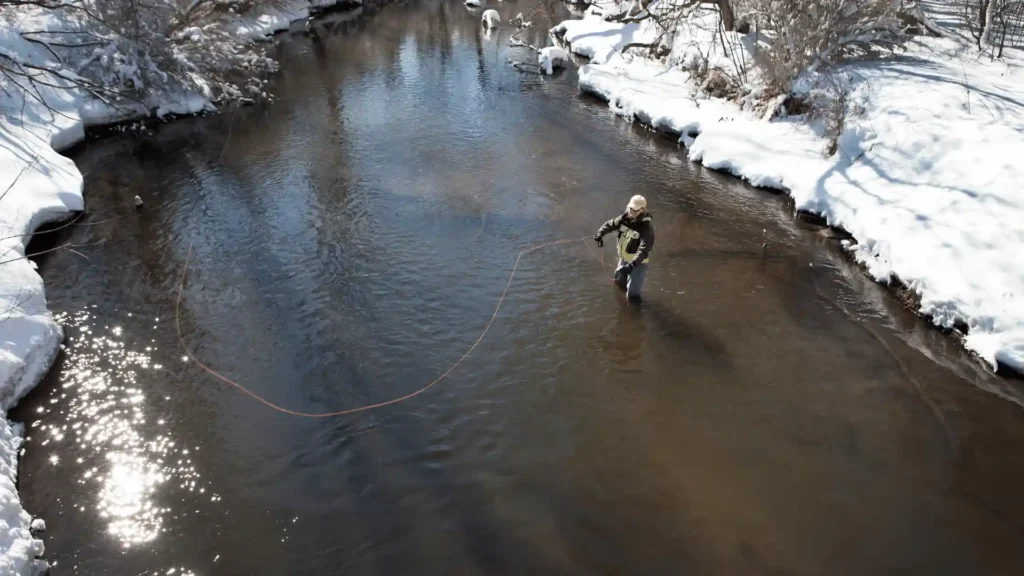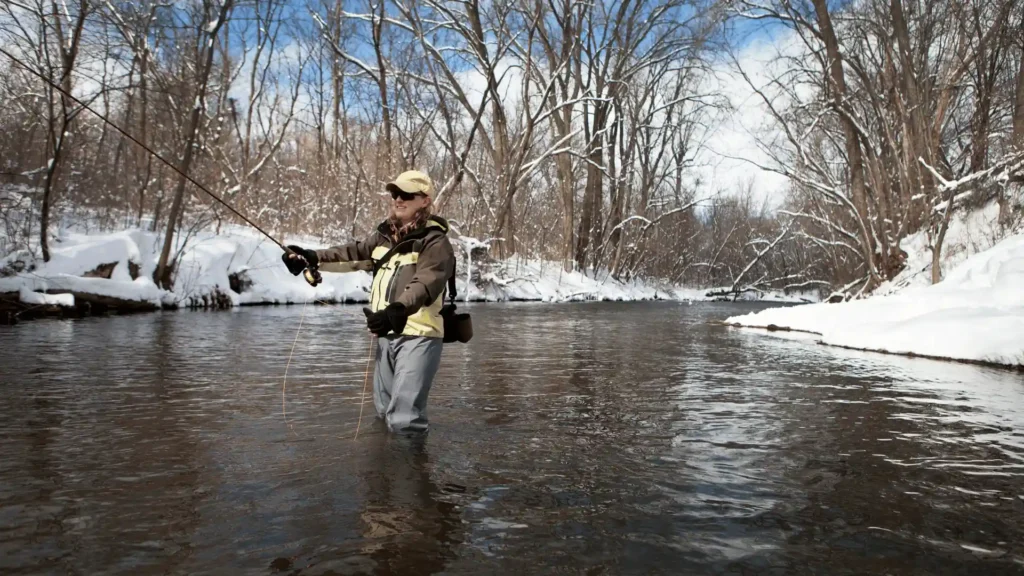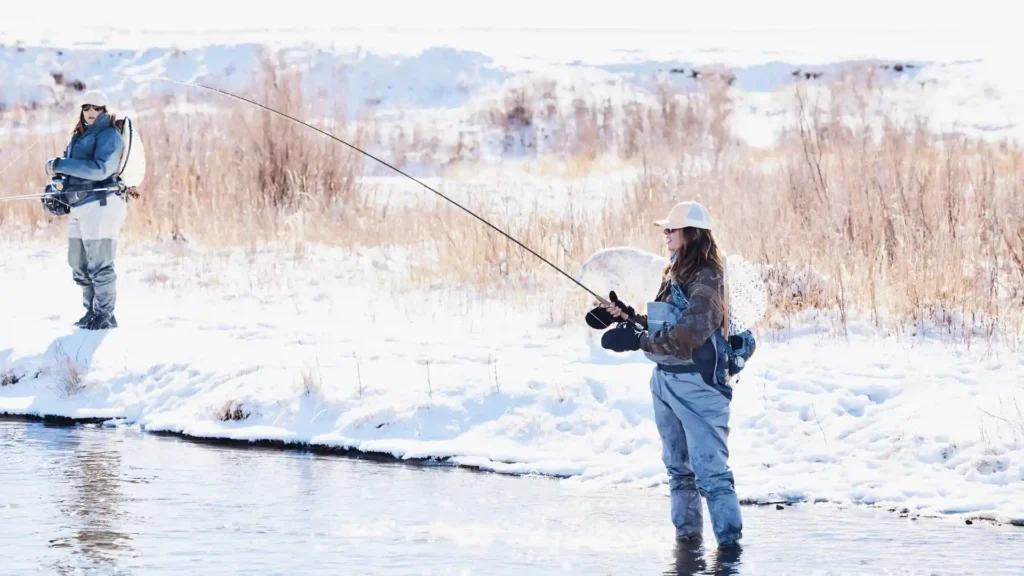Fly Fishing in the Winter | 15 Things to Know

Are you drawn to the charm of a stunning river, even when winter is at its peak? Does wading into icy waters with a fly rod excite you? If so, fellow angler, this guide is just for you!
Winter brings its challenges for trout fishing, with cold weather making our elusive targets less active and more challenging to tempt. However, with the proper fly patterns, you can keep your passion for fly fishing alive all year round.
In this Guide, we will discuss how to fly fish for trout in winter, tips, and some best techniques to help you in your journey. So, lets dive in.
Must Read: An In-depth Guide on Fly Fishing Tippet
Can You Fly Fish in the Winter?
Yes, you can fly fish in winter. Winter brings a different kind of magic to the world of fly fishing. While some may argue that it’s not ideal, there are plenty of reasons why you should try it. First and foremost, winter fly fishing offers solitude like no other season.

With fewer anglers braving the cold, you’ll have the rivers all to yourself – just you and nature in perfect harmony.
Moreover! Many experienced anglers believe that trout become more active during colder months as they seek food sources beneath the water’s surface. So, while dry fly action might be limited, nymphing becomes incredibly productive.
And let’s remember streamer fishing. Those big, aggressive trout lurking in deep pools can’t resist a well-presented streamer.
Of course, when venturing out for winter fly fishing, it’s essential to consider how cold is too cold for your comfort level and safety. Some anglers are okay with bundling up in multiple layers and facing freezing temperatures head-on.
In contrast, others prefer slightly milder conditions around the freezing point (32°F or 0°C). It boils down to personal preference and how much you’re willing to endure for your love of angling.
So, suppose you’re up for an adventure and willing to brave the elements with proper gear and precautions (which we’ll discuss later). In that case, fly fishing can be good in the winter!
Patience is key, as fish tend to move slower in colder waters. But trust me when I say that landing a trophy catch amidst a snow-covered landscape is an experience like no other.
How cold is too cold for fly fishing?
A critical question about fly fishing in the winter is: how cold is too cold? While there isn’t a definitive answer, it’s safe to say that extreme temperatures can make for challenging fishing conditions.
I prefer water temperatures between 40-60 degrees Fahrenheit, as this range tends to be the most productive for catching trout. However, some anglers are willing to brave colder temperatures with the right gear and tactics.
That said, when the air temperature drops below freezing and ice starts forming on the water’s surface, it becomes much more difficult (and dangerous) to fish effectively.
Ice can impede the casting and retrieving of flies, making it nearly impossible to present your offering correctly.
Additionally, freezing weather can also affect fish behavior. Trout tend to become less active in frigid conditions and may retreat deeper into slower-moving pools or seek shelter near submerged structures like rocks or fallen trees.
While winter fly fishing can be rewarding with proper preparation and knowledge of where fish hold in colder months, there is a limit to how hard it is too cold for successful angling adventures.
Recommended: How To Fish Emerger For Trout
Where do trout hold in winter?
During the winter months, trout seek refuge in areas where they can find warmer water and protection from the elements.
One common place you’ll find trout holding in winter is near deep pools or slow-moving river sections. These areas provide a more stable environment for fish to conserve energy and stay out of the fast current.
Look for pockets of slower water where trout can rest without expending too much energy.
Another popular spot to find trout during winter is around submerged structures such as fallen trees or large rocks. These structures create a natural cover for fish, shielding them from harsh weather conditions and providing a haven.
Trout also congregates near underwater springs or tributaries that feed into the main river.
These areas often have slightly warmer water temperatures due to groundwater sources or runoff, making them attractive feeding grounds for hungry trout.
When fishing in winter, it’s essential to approach these holding spots cautiously. Trout are more sluggish during cold temperatures, so avoid spooking them with loud noises or sudden movements.
Take your time and make stealthy casts to increase your chances of success.
Every fishing location is different, so observing and adapting your strategy is always best. Understanding where trout hold in winter, you’ll be better equipped to target these elusive fish even when the temperature drops below freezing!
Must Read: History of Fly Fishing
Winter Fly Fishing Tips and Tactics
Winter presents distinct challenges for anglers, making it a season ripe for skill development. Here are some key facts about fly fishing in the winter months.
1. Check the Weather
Timing is crucial in winter fishing. Aim to fish on days leading up to or during a storm when clouds prevail. Avoid bright, clear days after a storm as water temperatures plummet, reducing feeding activity.
2. Time it Right
Wait to venture out too early. Wait until mid to late morning when the bite picks up. Stay on the water during the short feeding window when midges hatch, turning dead water into lively feeding zones.
3. Seek Warm Water
Trout feed only when water temperatures are stable or rising. Look for areas influenced by hot springs, tailwater dams, or warm water outflows where trout are more likely to feed.
4. Target Deep, Slow Water
Focus on slow runs and deep holes where trout congregate during winter. Avoid shallow, fast water until spring arrives.
5. Fish Slowly
Instead of covering a lot of water, focus on methodically fishing one or two large, deep holes where trout are concentrated. Take your time and cover every inch of the hole.
6. Use Adequate Weight
Ensure your flies are deep enough to reach the bottom where trout feed. Use a long leader and enough weight to keep your flies bouncing off the bottom.
7. Opt for Rubber Soles
Choose rubber-soled wading boots over felt soles to prevent snow from freezing onto your soles, making walking safer in deep snow.
8. Slow Down
Cold water slows fish metabolism, so adjust your fishing accordingly. Strip streamers slowly, let nymph rigs drift entirely, and minimize sudden movements to avoid startling fish in clear waters.
9. Sleep In
Fish aren’t typically active until later in the morning during winter. Take advantage of this by getting more rest and hitting the water later in the day when fish are more likely to feed.
10. Less Crowded Waters
Winter months see fewer anglers on the river, offering more space and tranquility. Take advantage of this quieter time to enjoy the solitude and focus on your fishing without the crowds.
11. Unfrozen Rivers
Most rivers, especially tailwaters, don’t freeze completely during winter. Tailwaters, fed by dams, maintain more consistent temperatures year-round, providing opportunities for winter fishing without worrying about ice.
12. Dress Appropriately
Dress in layers with synthetic or merino wool clothing to stay warm. Avoid cotton clothing, as it retains moisture. Carry extra dry clothes in case you get wet.
13. Simplify Fly Selection
Stick to general patterns like midge larvae and pupae, attractors, stoneflies, worms, and eggs. Bulky streamers can also be effective, especially during winter months.
14. Less is more …
Tube flies come in various patterns designed for different fishing conditions:
- Tippet: In low and clear winter waters, fish can spot your rig easily. Try using a thinner tippet size, like 5X, instead of your usual 4X, to make your setup less conspicuous.
- Strike Indicators: With clear flows, strike indicators can spook fish. Consider ditching the indicator and opt for Czech-style high-sticking, or watch the leader for subtle movements.
- Socks: Avoid wearing too many socks in your waders, restricting blood circulation. Stick to mid to heavyweight socks to keep your toes warm without sacrificing circulation.
15. Exercise Caution
Avoid taking unnecessary risks, such as crossing rivers in unsafe conditions or standing on ice shelves over deep water. Stay in shallow water if wading, and never wade too deep in freezing temperatures.
Recommended: What is a Tippet Fly Fishing
If You want More Tips Like this You can Check out Rhys Fishing.
Winter Fishing Wearing Equipment
Winter angling presents challenges, but with the right gear, you can brave the cold and keep fishing. Here’s what to wear:

- Hands: Cold hands can ruin a day. Bring fingerless wool gloves for warmth and function, plus a pair of flip-down mittens for extra cold days. Keep your off hand warm in the mitten while casting, then switch to gloves for tasks like tying knots or handling fish.
- Feet: Numb toes are a nightmare. Wear two pairs of socks – a thin athletic pair underneath and thick wool socks on top. Walking around keeps blood flowing, crucial for warmth in near-freezing water.
- Layers: Dress in layers and have extras in the car. Weather changes fast, so be prepared. Consider lightweight yet warm options like long sleeve tees, fleece quarter zips, hoodies, and wind-cutting jackets. Keep additional layers in the truck for unexpected cold snaps or accidents.
Match the Winter Hatch
One of the key strategies for successful winter fly fishing is matching the hatch. While it may not be as prolific as in other seasons, there are still insect hatches that trout feed on happening in winter.
Observing and imitating these insects is essential to increase your chances of hooking a fish.
In winter, midges are often the most prevalent insect species. These tiny flies can be found hatching throughout the day, so having a selection of midge patterns in sizes 16-20 is essential.
Rainbow Warrior Midges and Zebra Midges are popular choices among anglers.
Additionally, stoneflies and mayflies can also make an appearance during warmer periods or on overcast days.
Some nymph patterns like Pheasant Tails or Prince Nymphs in sizes 12-18 can prove effective when imitating these more giant insects.
When selecting your fly patterns, it’s crucial to consider color variations too. In colder water temperatures, trout tend to have slower metabolisms and may be less active.
Opt for darker colors such as blacks, browns, olives, and purples for better visibility underwater.
Remember that presentation is as important as pattern selection when matching the winter hatch. Trout will scrutinize every detail before deciding whether to strike or not. Focus on delicate casts with proper drifts to mimic natural movement.
Paying attention to what insects are present and using appropriate fly patterns with careful presentation will significantly increase your chances of success while fishing in the winter months!
Which Water is Best for Fly Fishing in Winter?
In winter, trout hang out in the stream’s most significant, deepest, and slowest parts. These areas provide them with easy living conditions where they can conserve energy.
Deepwater also protects them from predators and ice.
Trout still need to eat, so they’ll venture into tail-outs and riffles near deep runs to find food. Make sure to fish through the entire stretch of water.
Tailwaters (streams below dams) usually have the most consistent fishing in areas where rivers freeze over because the water stays above freezing. Spring-fed and geothermally influenced streams offer similar advantages.
Some freestone streams also offer excellent cold-weather fishing, but geography matters. Streams with more sunlight tend to have less ice. For example, the Blackfoot River in western Montana freezes quickly due to its shaded canyon.
At the same time, the nearby Bitterroot River stays open longer because of its sun-exposed valley.
Best Winter Nymphing Strategies
During winter, most of the action happens beneath the surface. Short-line or high-stick nymphing is the go-to strategy on smaller streams because it minimizes spooking fish.
However, adjust your tactics on more significant streams accordingly, as short-line nymphing may have limitations.
Utilize a tandem nymphing rig with two or three nymphs, a split shot covered with moldable putty for easy adjustments, and a yarn strike indicator. Longer leaders (9′ or 12′) are preferable in winter to reach deeper water where fish are concentrated.
Trout in flat water has ample time to inspect flies, so target areas with a slightly bumpy surface for better bottom structure and quicker decisions.
Approach trout cautiously to minimize spooking, reducing the fly line on the water and ice buildup in the guides. Roll-cast your flies upstream at a 45-degree angle and lift the fly line above the strike indicator to prevent drag.
Manage the fly line carefully by stripping slack with your non-casting hand’s thumb and index finger. Slowly lower the rod tip once your flies drift downstream to extend the drift.
Set the hook promptly after the drift, as the tightening leader often triggers a strike.
If sight-fishing to a specific fish, recast your flies once they pass the target, focusing on visible fish rather than unseen ones. Keep your flies before the fish to maximize the drift and avoid wasting time.
Choose a strike indicator that suits your needs, with yarn indicators most sensitive to subtle strikes. Adjust the indicator to 1½ to 2 times the water depth from the weight to improve strike detection.
Be attentive to subtle strikes, as up to a third may go unnoticed by the indicator, especially in slower currents.
Watch for fish movements indicating a strike, such as rising in the water column or opening their mouths, and set the hook accordingly.
Safety Tips for Winter Fishing
Winter fishing comes with its own set of safety concerns due to the cold weather. Here are some essential tips to keep in mind to ensure your safety:
- Stay on the shore instead of wading into icy water if possible. If you do need to wade, make sure you’re wearing appropriate winter gear.
- Avoid walking on ice that covers moving water, even if it looks sturdy.
- Always fish with a buddy so you can watch out for each other.
- Don’t forget to bring essential items like raincoats, hats, gloves, and any other gear you might need to stay warm.
- Be mindful of how quickly it gets dark in the winter, and plan your fishing trip accordingly.
Following these safety tips, you can enjoy winter fishing safely and maximize your time outdoors.

Meet Ibrahim Khan, an avid angler and author in Fishing Teach. He shares his wealth of knowledge from his 16 years of experiences in fishing. His articles are a captivating blend of practical insights and thrilling tales that invite readers into the enchanting world of fishing.
Ibrahim’s guides are your go-to guide in the realm of fishing on this informational site. Hailing from a coastal paradise, Ibrahim’s passion for angling is the heartbeat of his life.
